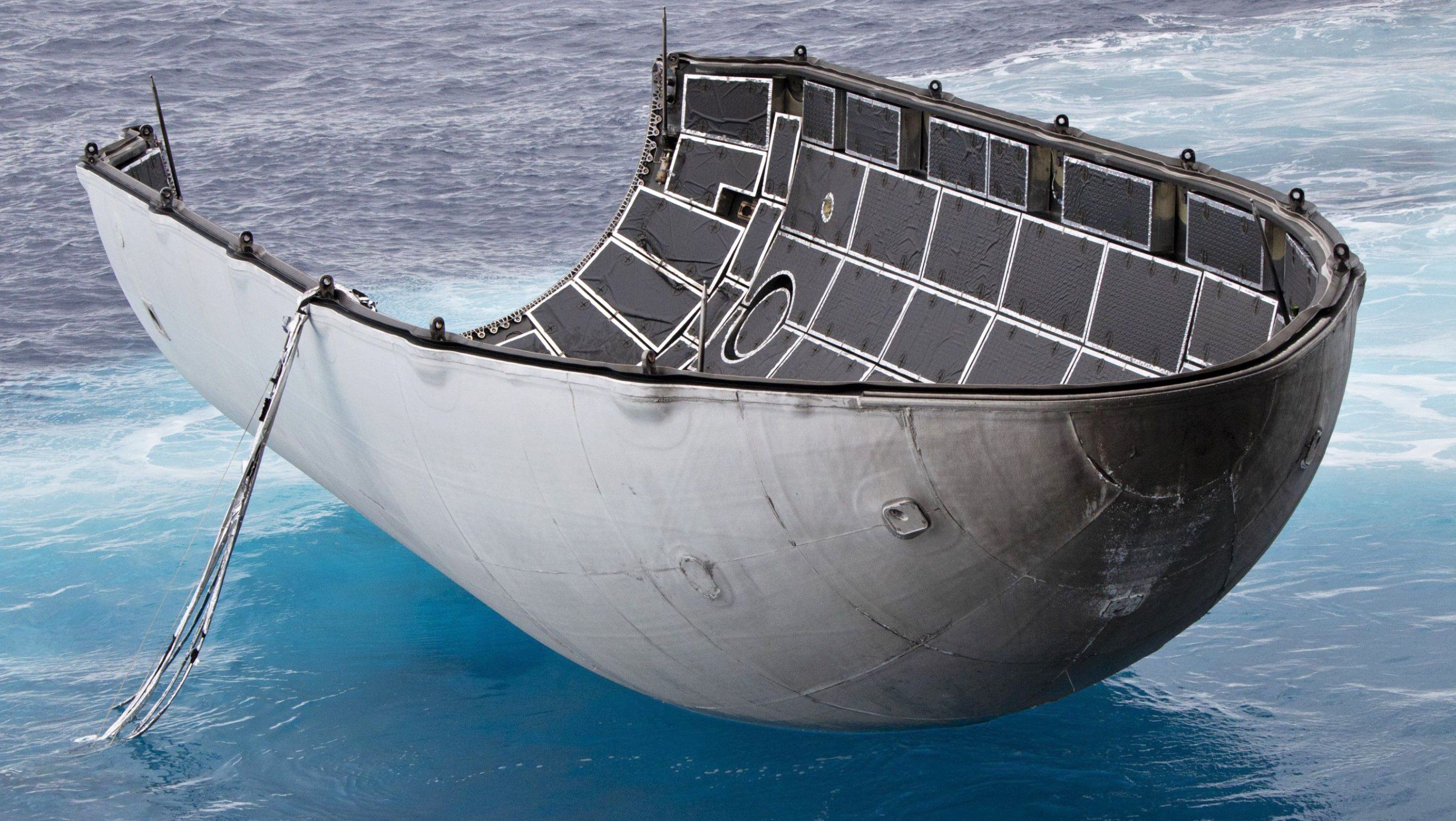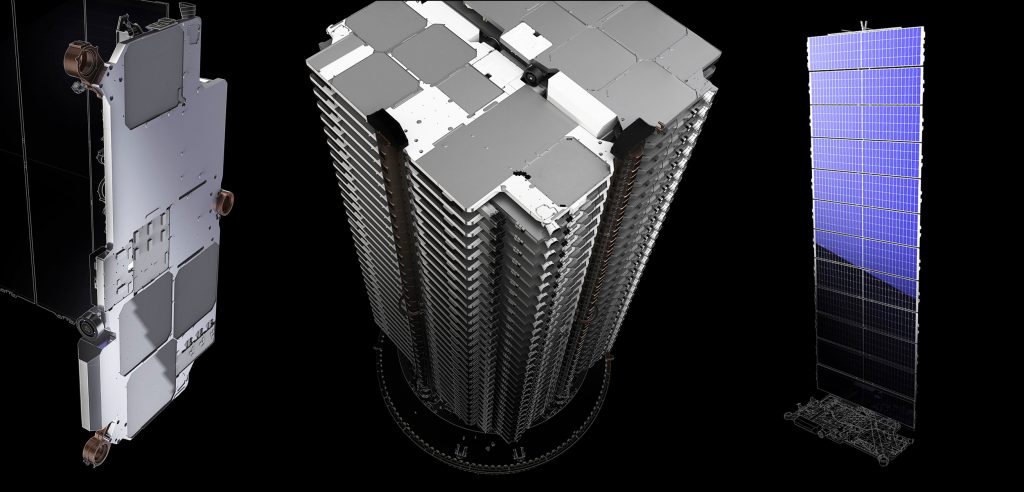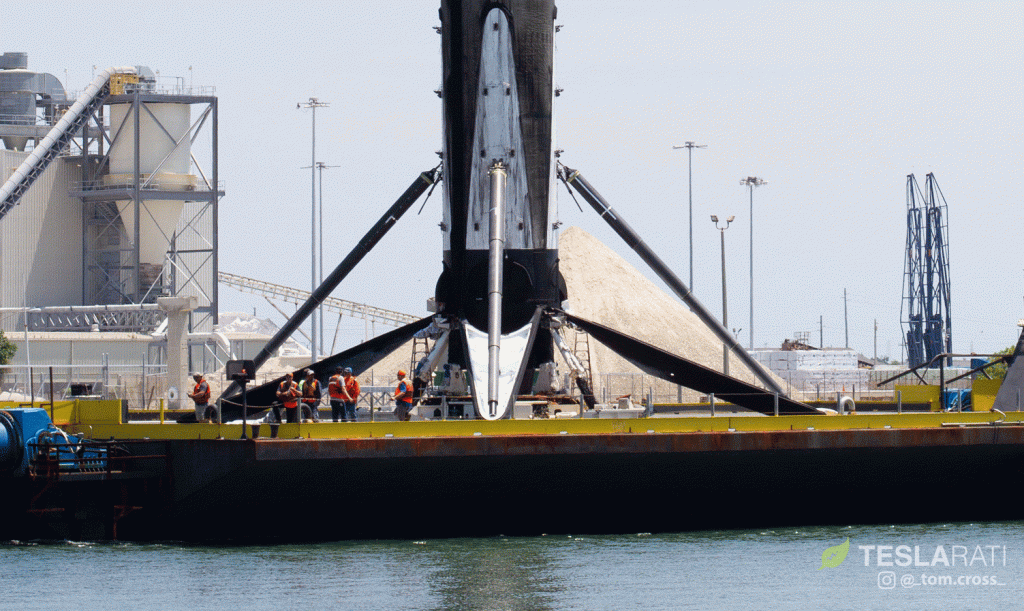

News
SpaceX’s next Falcon 9 launches get a bit closer as hardware arrives in Florida
On September 18th, local Florida resident Andrew Stoltz happened to be at the exact right place and time to catch a new SpaceX Falcon 9 fairing on the last leg of its journey to Cape Canaveral.
Likely the payload fairing that will support one of three upcoming launches, this hardware at least partially symbolizes the imminent end of an almost unprecedented lull in launch activities, rivaled only by post-failure groundings in 2015 and 2016. Described earlier this month by SpaceX’s President and COO, the company’s rockets and launch sites are consistently ready and waiting on customer payloads for the first time ever.
Simultaneously, SpaceX is working to prepare its own long-term solution for similar customer-side lulls in launches, coming in the form of dozens upon dozens of internal Starlink satellite missions. Assuming every Starlink mission involves ~60 satellites and relies on Falcon 9, SpaceX will need to complete nearly 100 launches between now and 2024 and another ~100 by 2027, demanding an average of 2-4 launches per month.
SpaceX completed its last orbital launch on August 7th, placing the AMOS-17 communications satellite into a geostationary transfer orbit (GTO) on an exceedingly rare expendable Falcon 9. As of then, SpaceX’s next launch – an internal Starlink mission – was already expected no earlier than October and has since settled towards the end of the month. First reported by NASASpaceflight.com, the first Starlink v1.0 mission (AKA Starlink-1) is tentatively scheduled to launch no earlier than (NET) October 17th, followed by Starlink-2 NET November 4th and Starlink-3 NET late-November.

Of note, there have been whispers in the last few days that SpaceX’s next launch is not, in fact, a Starlink mission. Reading between the lines, only two possible spacecraft – JCSAT-18/Kacific-1 or South Korea’s ANASIS – are next on SpaceX’s manifest, the former of which is scheduled to launch no earlier than November 11th and the latter of which does not yet have a firm date.
Given that SpaceX is wrapping up the redesign and requalification work needed for Starlink to graduate from “v0.9” to “v1.0” and mass-producing high-performance spacecraft at an utterly unprecedented rate, the company’s next few Starlink launches are certainly at high risk of delay. For now, it’s safe to assume that the next SpaceX launch is still scheduled sometime in October until additional information is available. However, if rumors of the next mission not being Starlink are true, SpaceX’s next launch could come as late as mid-November.

This would translate to a more than 90-day gap between launches for SpaceX, unprecedented for the company outside of Falcon 9’s two (of two) catastrophic failures. An in-flight failure during the June 2015 CRS-7 launch caused a delay of more than six months between launches, while Falcon 9’s on-pad Amos-6 anomaly grounded SpaceX for roughly 4.5 months. More likely than not, the 2-3 month lull is the consequence of an unprecedented lack of flight-ready customer satellites, as well as the not-quite-ready status of SpaceX’s own Starlink satellites.
Starlink thus wasn’t quite ready to fill the gap, but SpaceX wants that to change as soon as possible. President and COO Gwynne Shotwell revealed earlier this month that the company has up to 24 Starlink launches planned on top of its customer missions in 2020, the former of which would – on its own – handily defeat SpaceX’s current annual record of 21 launches. The plan is to mix in Starlink launches in such a way that SpaceX’s own launch needs create little to no disruption for the company’s paying customers.
For now, we’ll have to wait and see which upcoming mission the spotted Falcon fairing is meant to support. SpaceX has two flight-proven fairing halves after a successful second recovery last month, potentially meaning that the company could launch its first fully (or even just partially) flight-proven fairing as early as next month.
Check out Teslarati’s Marketplace! We offer Tesla accessories, including for the Tesla Cybertruck and Tesla Model 3.
Elon Musk
Elon Musk confirms Grok 4 launch on July 9 with livestream event
The rollout will be accompanied by a livestream at 8 p.m. Pacific Time.

Elon Musk has officially confirmed that Grok 4, the latest version of xAI’s large language model, will launch on July 9. The rollout will be accompanied by a livestream at 8 p.m. Pacific Time, hosted on xAI’s official account on X.
xAI goes straight to Grok 4
Back in May, leaks indicated that xAI was getting ready to ship Grok 3.5. Considering Musk’s recent comments, however, it appears that the artificial intelligence startup would be focusing on the large language model’s fourth iteration instead. As noted in a Financial Express report, users on X have sighted references to Grok 4 in the lead up to the update’s launch, such as “grok-4-prod-mimic” and “Grok 4 Code.”
Musk’s Grok 4 announcement comes as AI competition intensifies between major players including OpenAI, Google, and xAI. With Musk’s Colossus supercomputer fully operational in Memphis, xAI appears to be accelerating its AI product roadmap.
Musk pushes Grok toward political neutrality
Grok 4’s launch also follows a recent controversy involving political bias, as noted in a CNN report. Last week, Grok responded to a user on X stating that political violence in the U.S. since 2016 had come more from the political right than the left. The chatbot noted in a later reply that its answer was based on information from sources like Reuters, the Journal of Democracy, and University of Maryland studies.
Musk stated that Grok’s response was a “major fail.” “Major fail, as this is objectively false. Grok is parroting legacy media. Working on it,” he wrote in a post on X. By the end of June, Musk noted that he was “grinding all night with the xAI team” and that they were making “good progress.” He also stated that the model “Will be called Grok 4. Release just after July 4th. Needs one more big run for a specialized coding model.”
News
Tesla opens massive solar Supercharger station in California
The Supercharger opened to customers ahead of Fourth of July weekend, while Tesla continues phase two of construction on the site.

Tesla has officially launched the first several Supercharging posts at a massive station in California, notably including solar canopies and grid-scale batteries to offer completely renewable charging.
Last week, Tesla announced on X that it opened the first 84 Supercharger stalls of a planned 168-stall station in Lost Hills, California. Additionally, the massive Supercharger project features 11MW of solar canopies and 10 Megapack batteries for off-grid charging powered entirely by solar energy.
Tesla completed the first phase of the project just days ahead of the busy Fourth of July holiday weekend, adding that initial construction took just eight months. In addition to the remaining charging stalls, Tesla says it’s building a set of lounge areas, renderings of which can be seen below alongside current photos of the site.
Notably, the site also includes V4 charging posts for the company’s latest available charging speeds, and it’s located near the busy junction between I-5 and Highway 46 in Kern County.
“Thank you [Kern County] and [PG&E] for collaboration and approvals,” Tesla wrote in a follow-up post.

Credit: Tesla Charging | X

Credit: Tesla Charging | X

Credit: Tesla Charging | X

Credit: Tesla Charging | X
Tesla Supercharger Maps for North America, Europe, and Asia pic.twitter.com/0U5r0XRPyo
— TESLARATI (@Teslarati) July 2, 2025
READ MORE ON TESLA SUPERCHARGERS: Tesla launches ultra-fast V4 Superchargers in China for the first time
Testing at the LA Diner, plus Musk update on potential Tesla solar Gigafactory
The huge Tesla Supercharger station completed phase one of construction fairly quickly, especially given how long Tesla has been working on its unique Los Angeles diner, drive-in, and Supercharger location. Still, the company was seen performing some testing at the nearly-completed charging station earlier this month, and will reportedly be holding a job fair.
Elon Musk also responded on Monday morning to a post on X, suggesting that Tesla is “thinking about” building a U.S.-based solar Gigafactory in order to help support increased power needs with AI growth, and to bolster domestic solar production.
Tesla is building a new UFO-inspired Supercharger in the heart of Alien country
News
Tesla driver walks away from major accident with minor injuries
The driver sustained only minor injuries, and the exact cause of the crash remains under investigation.

The driver of a Tesla Model Y survived and walked away from a harrowing accident on Monday in California, only sustaining minor injuries despite the vehicle being impaled by a guardrail.
On Monday morning around 4:34 a.m., the Los Banos division of the California Highway Patrol (CHP) responded to the accident on I-5 near Panoche Road, involving a 23-year-old in a Tesla Model Y. According to a post on social media, the driver veered off the road for unknown reasons in the northbound lane, before crashing directly into the guardrail and impaling the vehicle.
You can read the full message and photos from Los Banos CHP below, as were shared in a Facebook post on Monday afternoon.
This morning a Tesla model y was traveling in the #1 northbound lane of I-5 north of Panoche Rd. For unknown reasons driver allowed V-1 to veer off the roadway, travel through a dirt center divide, and crashed into the fixed metal guardrail. Lucky for the driver he only sustained minor injuries and was able to walk away. Driving a vehicle requires 100% attention to the road. Avoid distractions and focus on driving.

Credit: CHP Los Banos (via Facebook)

Credit: CHP Los Banos (via Facebook)

Credit: CHP Los Banos (via Facebook)
In a statement to SFGate, CHP officer Myles Anderson said that the driver only sustained minor injuries, while no arrests are made and drugs and alcohol are not suspected to have been involved. The report also notes that Tesla’s “cruise control and lane assistance features” were activated, according to Anderson. However, it’s not entirely clear if this is referring to Supervised Full Self-Driving (FSD), or to the cruise control and lane assist features baked into Autopilot.
At the time of writing, CHP has not yet responded to Teslarati’s request for clarification and additional details on the matter.
Tesla Crash Safety Ratings across its lineup: pic.twitter.com/ny30R7ceji
— TESLARATI (@Teslarati) July 1, 2025
READ MORE ON TESLA SAFETY: Tesla rolls out crucial new safety feature aimed at saving children
The news comes after Tesla has touted its vehicles as incredibly safe for many years. In December, for example, the company highlighted receiving top safety scores from regulators on four different continents throughout the world, including from the National Highway Traffic Safety Administration (NHTSA) and the Insurance Institute of Highway Safety (IIHS) in the U.S.
Tesla has also listed the goal of making its vehicles the safest on the road throughout the years, both in the overall design of its vehicles and in its Autopilot and Full Self-Driving (FSD) programs.
Tesla Model 3 ranks as the safest new car in Europe for 2025, per Euro NCAP tests
-

 Elon Musk1 week ago
Elon Musk1 week agoTesla investors will be shocked by Jim Cramer’s latest assessment
-

 News2 weeks ago
News2 weeks agoTesla Robotaxi’s biggest challenge seems to be this one thing
-

 News2 weeks ago
News2 weeks agoWatch the first true Tesla Robotaxi intervention by safety monitor
-

 Elon Musk2 weeks ago
Elon Musk2 weeks agoA Tesla just delivered itself to a customer autonomously, Elon Musk confirms
-

 News2 weeks ago
News2 weeks agoTesla Robotaxi rollout proves that Elon Musk still delivers, even if it’s late
-

 Elon Musk2 weeks ago
Elon Musk2 weeks agoxAI welcomes Memphis pollution results, environmental groups push back
-

 Elon Musk2 weeks ago
Elon Musk2 weeks agoElon Musk commends Tesla team on successful Robotaxi launch
-

 Elon Musk2 weeks ago
Elon Musk2 weeks agoElon Musk confirms Tesla Optimus V3 already uses Grok voice AI


















